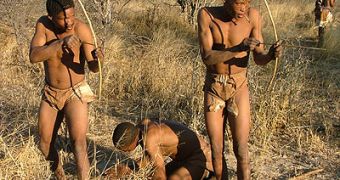The 6 billion humans inhabiting the Earth are here by sheer casualty. 74,000 years ago, the human species was at the brink of extinction, with a mere census of 2,000 individuals who finally managed to overcome the crisis and transmit their genetic pool to the modern man.
The crisis coincided with the first migrations of Homo sapiens out of Africa. Scientists cannot even say if the about 2,000 surviving humans formed a sole population or lived in isolation.
This low population census and genetic bottleneck explains why humans are so similar among them while in the case of the ape species, this does not happen. The DNA analyses that detected this bottleneck also revealed the oldest human race: Khoisan (Bushmen), now restricted to South Africa, being at least 100,000 years old. The second oldest race was that of the pygmy. DNA analysis was made on African pygmies, but the race migrated early to New Guinea, Philippines (Aeta), Malaya (Semang), Thailand (Mani), Andaman archipelago, Flores (Rampasasa) and Vanuatu archipelago, when most of these lands formed one ground or were separated by narrow seas.
The cause of the disaster experienced by the first humans is increasingly put on a "volcanic winter", after the eruption of the Toba Mount from Sumatra. The event took place for 6 years and altered the clime to the point of inducing an especially tough Ice Age which lasted one thousand years.
The volcano expelled 720 cubic miles (3,000 cubic kilometers) of magma and huge quantities of sulfuric acid that reached even Greenland. Ice cores clime records revealed that the world got colder by 5.4 - 9? F (3 - 5? C) for the next millennium. This is the largest volcanic blast on Earth in the last two million years, and wrapped India in a 6-inch (15 cm) sheet of volcanic ash.
The Homo sapiens survived as they had already achieved a high complexity, revealed by the exhibition of early symbolism, complex toolmaking behavior and sophisticated social behavior.

 14 DAY TRIAL //
14 DAY TRIAL //